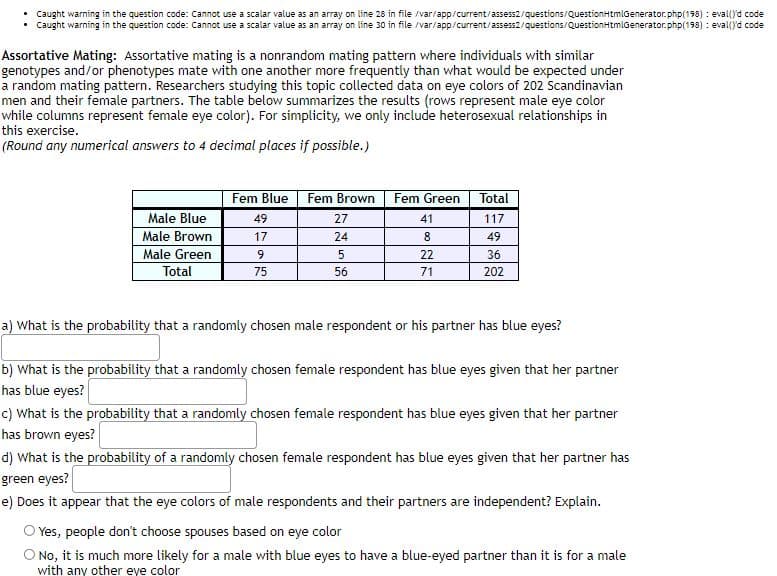Round any numerical answers to 4 decimal places if possible.) Fem Blue Fem Brown Fem Green Total Male Blue Male Brown Male Green Total 49 27 41 117 17 24 8 49 22 36 75 56 71 202 ) What is the probability that a randomly chosen male respondent or his partner has blue eyes? )What is the probability that a randomly chosen female respondent has blue eyes given that her partner as blue eyes? What is the probability that a randomly chosen female respondent has blue eyes given that her partner as brown eyes? )What is the probability of a randomly chosen female respondent has blue eyes given that her partner has reen eyes? ) Does it appear that the eye colors of male respondents and their partners are independent? Explain. O Yes, people don't choose spouses based on eye color O No, it is much more likely for a male with blue eyes to have a blue-eyed partner than it is for a male with any ether eve seler
Round any numerical answers to 4 decimal places if possible.) Fem Blue Fem Brown Fem Green Total Male Blue Male Brown Male Green Total 49 27 41 117 17 24 8 49 22 36 75 56 71 202 ) What is the probability that a randomly chosen male respondent or his partner has blue eyes? )What is the probability that a randomly chosen female respondent has blue eyes given that her partner as blue eyes? What is the probability that a randomly chosen female respondent has blue eyes given that her partner as brown eyes? )What is the probability of a randomly chosen female respondent has blue eyes given that her partner has reen eyes? ) Does it appear that the eye colors of male respondents and their partners are independent? Explain. O Yes, people don't choose spouses based on eye color O No, it is much more likely for a male with blue eyes to have a blue-eyed partner than it is for a male with any ether eve seler
Chapter4: Systems Of Linear Equations
Section4.6: Solve Systems Of Equations Using Determinants
Problem 279E: Explain the steps for solving a system of equations using Cramer’s rule.
Related questions
Question

Transcribed Image Text:• Caught warning in the question code: Cannot use a scalar value as an array on line 28 in file /var/app/current/assess2/questions/QuestionHtmlGenerator.php(198) : eval(yd code
• Caught warning in the question code: Cannot use a scalar value as an array on line 30 in file /var/app/current/assess2/questions/QuestionHtmlGenerator.php(198) : eval(yd code
Assortative Mating: Assortative mating is a nonrandom mating pattern where individuals with similar
genotypes and/or phenotypes mate with one another more frequently than what would be expected under
a random mating pattern. Researchers studying this topic collected data on eye colors of 202 Scandinavian
men and their female partners. The table below summarizes the results (rows represent male eye color
while columns represent female eye color). For simplicity, we only include heterosexual relationships in
this exercise.
(Round any numerical answers to 4 decimal places if possible.)
Fem Blue
Fem Brown
Fem Green
Total
Male Blue
49
27
41
117
Male Brown
17
24
8
49
Male Green
Total
9
22
36
75
56
71
202
a) What is the probability that a randomly chosen male respondent or his partner has blue eyes?
b) What is the probability that a randomly chosen female respondent has blue eyes given that her partner
has blue eyes?
c) What is the probability that a randomly chosen female respondent has blue eyes given that her partner
has brown eyes?
d) What is the probability of a randomly chosen female respondent has blue eyes given that her partner has
green eyes?
e) Does it appear that the eye colors of male respondents and their partners are independent? Explain.
Yes, people don't choose spouses based on eye color
O No, it is much more likely for a male with blue eyes to have a blue-eyed partner than it is for a male
with any other eye color
Expert Solution
This question has been solved!
Explore an expertly crafted, step-by-step solution for a thorough understanding of key concepts.
Step by step
Solved in 3 steps with 2 images

Recommended textbooks for you

